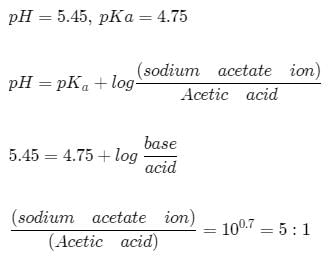Test: Ionic Equilibrium - 2 - SSS 2 MCQ
20 Questions MCQ Test - Test: Ionic Equilibrium - 2
What percentage of ammonia is given after cooling equilibrium mixture by Haber process?
. What is the molar solubility (s) of Ba3(PO4)2 in terms of Ksp?
Which of the following is more acidic? A solution with pH 5 or a solution with pH 3
A 0.10 M solution of a weak acid, HX, is 0.059% ionized. Evaluate Ka for the acid.
In a sample of pure water, only one of the following statements is always true at all conditions of temperature and pressure.
The pH of a 0.02 M solution of an unknown weak acid is 3.7. What is the pKa of this acid?
Which one is the correct expression below for the solution containing 'n' number of weak acids?
The pH of glycine at the first half equivalence point is 2.34 and that at second half equivalence paint is 9.60. At the equivalence point (The first inflection point) The pH is :
A 1.458 g of Mg reacts with 80.0 ml of a HCI solution whose pH is -0.477. The change in pH after all Mg has reacted. (Assume constant volume. Mg = 24.3 g/mol.)(log 3 = 0.477)
The ionization constant of benzoic acid is 6.46 x 10-5 and lc for silver benzoate is 2.5 x 10-13. How many times silver benzoate more soluble in a buffer of pH = 3.19 as compared to its solubility in pure water?
A certain acid-base indicator is red in acid solution and blue in basic solution 75% of the indicator is present in the solution in its blue form at pH = 5. Calculate the pH at which the indicator shows 90% red form?
Which of the following concentrations of NH4+ will be sufficient to prevent the precipitation of Mg(OH)2 from a solution which is 0.01 M MgCl2 and 0.1 M NH3 (aq).
Given that : K5 of Mg (OH)2 = 2.5 x 10-11 and Kb for NH3(aq) = 2 x 10-6.
An acid-base indicator which is a weak acid has a pKa value = 5.45. At what cocentration ratio of sodium acetate to acetic acid would the indicator show a colour half-way between those of its acid and conjugate base forms? pKa of acetic acid = 4.75. [log 2 = 0.3]
The indicator constant of phenolphthalein is approximately 10-10. A solution is prepared by adding 100.01 c.c. of 0.01 N sodium hydroxide to 100.00 c.c. of 0.01N hydrochloric acid. If a few drops of phenolphthalein are now added, what fraction of the indicator is converted to its coloured form?
A buffer solution is made by mixing a weak acid HA (Ka = 10-6) with its salt NaA in equal amounts. What should be the amount of acid or salt that should be added to make 90 ml of buffer solution of buffer capacity. 0.1 ?
Statement-1 : solubility of BaSO4 in 0.1 M Na2SO4 is 10-9 M hence its K8 is 10-18.
Statement-2 : because for BaSO4 Ksp = (s)2 [symbols have their usual meanings].
Statement-1 : It is difficult to distinguish the strengths of the strong acids such as HCI, H2SO4, HNO3,HBr, HI or HCIO4 in dilute aqueous solutions.
Statement-2 : In dilute aqueous solution all strong acids donate a proton to water and are essentially. 100% ionised to produce a solution containing H30+ ions plus the anions of strong acid .
The degree of dissociation of water in a 0.1 M aqueous solution of HC1 at a cedain temperature t°C is 3.6 x 10-15. The temperature t must be :












 moles = 11 m moles
moles = 11 m moles















